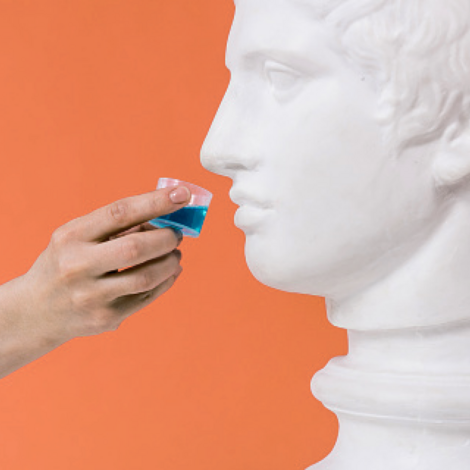Your body is designed for sleep, says the psychotherapist Heather Darwall-Smith. It’s not something you have to “perform.” It’s such an innate drive, if you’re sleep-deprived or even bored, you can drop off while doing 70 down the M25, she says. Notably, “The brain is off somewhere else.” Its effort isn’t required. “Biologically, your body knows how to sleep.”
That’s not to minimize the utter despair and distress of insomnia. Darwall-Smith specializes in sleep, and has worked with hundreds of individuals, in sleep clinics and private practice, who are exhausted by wakeful nights, anxious thoughts and a restless mind. What many endure, she says, is “horrific.” Even worse, “People blame themselves.” They’re not choosing this. “It breaks my heart regularly.”
Her focus is behavioral—“Right, what else is happening in your world?” Because how we think about sleep, and try to control it, often drives it away. If we get too anxious, “No amount of valerian tea or magnesium” will help because, broadly, we’ve scared our brain into staying awake. “People say, ‘I sleep because I do X, Y and Z.’ No you don’t.”
Talking to Darwall-Smith, one realizes that sleep is like a cat—it’s only when you stop chasing it and fussing that it will come to you. Her book How to Be Awake (So You Can Sleep Through the Night) is an empathetic and thorough exploration of why it’s so common to struggle, and what we can do about it. Here she shares her advice.
1. Allow sleep to be “messy”
“A lot of people that I see are very successful, capable and competent—and they’re really frustrated that they can’t sleep,” Darwall-Smith says. Many believe, “I’ve got to perfect my sleep, I’ve got to perfect the timing, I’ve got to get eight hours, I’ve got to optimize it.” They show her “reams of data from their devices.” If we’re fraught, it’s hardly our fault. The sleep guru Dr. Matthew Walker recently admitted he was too “puritanical,” she notes. His bestseller Why We Sleep convinced some that getting less than eight hours’ sleep was life shortening.
“His book did scare people,” Darwall-Smith says. Language around sleep also breeds rigidity. She likens the phrase “sleep hygiene” to “clean eating”—stick to narrow rules or fail. Despite the tech bros’ podcasts, protocols and culture of “If you do all this, then X will happen,” she says, “sleep hygiene is not a cure-all for everyone.” Especially if you’re obsessive: “Perfectionism is insomnia’s best friend, it’s a perpetuating factor.” You can do everything “right” and lie awake “because sleep is biological”—a complex physiological process—“it’s not just behavioral.”
2. Does your nervous system feel safe enough to sleep?
All that effort, energy and fear spent trying to control sleep is counterproductive as it puts you on alert, Darwall-Smith says. “Anything we hyper-focus on, we’re telling the brain, ‘This is important.’ If it thinks that, why is it going to let you sleep?” If we’re persistently stressed—whatever the cause—the subconscious feeling is that we’re not safe. So the brain won’t “turn off.” In fact, any “big” emotion—anger, excitement, anxiety—can override sleep. “The amygdala—the fear center at the back of the brain—is really active in people with insomnia,” she says. “Their brain stays in a state of alertness.”
Stress hormones keep us wakeful. “Cortisol is supposed to drop in the evening, but stress delays it. So it keeps us in that fight or flight mode.” Cortisol suppresses the release of melatonin. “You might be emotionally or physically safe, but you’re mentally overactive. The brain thinks you’re in danger—why is it going to let you sleep?” Even if you can drop off, “You’re likely to be more of a light sleeper,” she says. It’s a “red flag” to her if a patient is a light sleeper—“It tells me how active their nervous system is.”
She helps people to identify and understand why they’re hypervigilant. It could be current stressors, or past trauma such as being bullied at school. “You may be safe now. But your nervous system might not know that.”
3. Forget the device, keep a sleep diary
Keeping a “sleep diary” for one to two weeks can be more effective than a device (“they’re a guideline—we’re externalizing how we feel”) in helping you to understand your sleep patterns and needs, Darwall-Smith says. A holiday is a good time to try it. Track the time you naturally go to bed and the time you naturally wake, without an alarm. Record the amount of sleep you think you got. And how you feel, mentally and—importantly—physically.
Include “triggers” that affect your sleep. She notes that “sleep efficiency” of over 85 percent is used to judge if sleep is decent. Divide time spent asleep (TSA) by time in bed (TIB) and multiply by 100. That is, TSA, seven hours, divided by TIB, eight hours = 87.5 percent. Our sleep reflects our entire day, not the hour before bed, and important questions to reflect on include, “How long do I spend out of bed each day? How do I spend that time?”
4. Pace your daytime stress
If your day is nonstop “doing,” you’ll have no time to think. It’s only when your head hits the pillow that your mind, free of distraction, starts churning through significant emotions or events. Blame your brain’s default mode network (DMN), which “actives during rest to process lingering worries.” The DMN activity alerts our salience network, whose job it is to direct our attention to what’s important. Meaning, if your head is loaded with stuff you’ve not had time to reflect on during the day, it will be treated as urgent now, keeping you awake. It can mean your bed becomes “a place for worrying.”
Darwall-Smith likens the tired but wired mind to a shaken-up bottle of soda. “How do you open the lid so you let the pressure out slowly?” Perhaps a walk—no scrolling or podcasts. To improve sleep, we need to reduce the endless barrage of sensory input. If you can, take a short early-afternoon nap or just zone out. “If rest means closing your eyes for 20 minutes—hallelujah,” she says. “You get that chance to dial out, you’re shifting brain states, you might be shifting into light sleep, and you’ll get some restoration.” Or scribble down your worries after work. “Writing it down gets that material out of the brain and puts it somewhere. So it doesn’t have to keep spinning it.”
5. Try CBTi
Cognitive behavioral therapy for insomnia (CBTi) helps 70 to 80 percent of people improve their sleep. “It’s a toolbox that targets both thoughts and behaviors,” she says. “It’s breaking the cycle of wakefulness, so if you associate the bed with stress, CBTi will help your brain to create positive associations with it.” It’s also about naturally building “sleep pressure.” The longer you’re awake, the more sleep-promoting chemicals such as adenosine increase, which makes you sleepier. This is achieved by “sleep restriction,” which cuts the time you spend in bed, and usually takes from two to eight weeks.
Say you go to bed at ten and get up at seven, “that’s nine hours in bed,” Darwall-Smith says. Long times in bed can cause broken, shallow sleep. To boost “sleep efficacy,” a sleep schedule is set. If you get six hours’ sleep and need to wake at seven, you go to bed at one a.m. and rise at seven. “We’re deliberately cutting that time to consolidate sleep.” (Note: One hour of sleep before midnight is not worth two after. Your cells can’t tell the difference.) “You may get less sleep but we’re aiming for better quality, we want you to reach a better depth of sleep, and we want it to be more consistent.” As soon as you’re dropping off within 20 minutes, add 15 to 30 minutes of sleep per week. It’s hard work. Initially, you can feel lousy. “Oh my God, people hate me for it,” she says.
6. Fix your wake time—but an hour lie-in at weekends won’t hurt
There’s no getting away from the fact that fixing your wake time can be transformational for sleep. “It aligns all the biological processes in the body—digestion, everything,” she says. It “anchors” your wakefulness-boosting cortisol peak to a predictable hour, thereby stabilizing your sleep-inducing melatonin production in the evening. Plus, “The clocks in the body are incredibly routine-based.” A structured morning routine is “like drawing a line in the sand, and telling the body ‘This is where we stand.’” Think regularity, not rigidity. “We want to get that consistency in place, build the sleep pressure for later that night.” Must we get up at seven on weekends? No. Enjoy an hour’s lie-in, Darwall-Smith says firmly.
7. Awake at three a.m.? Sleep windows are like buses (another will be along soon)
When giving workshop talks, Darwall-Smith asks: “Who’s awake between three and four a.m.?” Most people raise their hands. “It’s perfectly normal.” What matters is “the nature of the waking.” If you’re groggy, relaxed, back to sleep you go. But some people panic, and that terror of staying awake becomes self-fulfilling. “It’s horrific for them.”
Most are somewhere in the middle. “You’re likely to feel sleepy again within 20 or 30 minutes. The two sleep processes—sleep pressure, and your circadian rhythm—work together to create a sleep window. And every sleep cycle has a sleep window. We know there’s going to be another one along soon.”
But if you can’t fall asleep? “Please go and do something else, don’t lie there torturing yourself. Plan for it, if you know it’s an issue.” Set up a cozy chair, a blanket, a low light. Hungry? Eat some toast. “What should happen, if you don’t freak out—easier said than done—the longer you’re awake, the more pressure builds.” Though she doesn’t underplay the hellishness of insomnia. “It’s terrifying when you’ve got a day at work.” She says that thanks to our body clock, “even with a night of no sleep, we know that you’re likely to feel OK in the morning. You’re like, ‘Oh I can’t go to sleep’—because that’s not what your timing is.”
8. Believe in your ability to sleep
On an overnight flight recently, Darwall-Smith slept terribly. “Excellent,” she thought. The next evening, “I’m going to have a great night!” She says: “The body has this homeostatic process—it will change your sleep to compensate for what’s been missed. Left to its own devices, it will alter sleep to give you the recovery you need. It will alter the depth of sleep, it will alter the amount of REM.” Though anxiety about sleep can delay it, “Sometimes that catch-up happens on night three or four.” But, crucially, “If we can get ourselves out of the way, the body knows how to do it. If the pressure builds up, and you’re quite sleep-deprived and there’s lots of adenosine in the system, you will go to sleep.”
How to Work Out Your True Sleep Needs
If you don’t struggle with insomnia and want to understand your natural sleep rhythm, the best way is to track your sleep over time when you don’t use an alarm clock. A holiday or extended break is ideal, as by the second week, your body usually settles into its natural rhythm. If you don’t have a break coming up, you can still learn a lot by using weekends or days off, allowing yourself to wake naturally and noting any patterns. It’s best to do this during a holiday when you don’t need an alarm clock. It’s often on the second week that you start to find where your natural sleep lies. But if you haven’t got a holiday coming up, we can still work this out. Use weekends or days off to allow yourself to sleep without an alarm. Track these days separately to compare with your usual sleep schedule. This can give you insight into your natural sleep pattern.
• Track bedtime: For two weeks, note the time you naturally go to bed.
• Track wake time: For two weeks, record the time you naturally wake up without an alarm or other interruptions.
• Track sleep quantity: For two weeks, record the amount of sleep you think you got.
• Work out your sleep efficiency score: We tend to look for a sleep efficiency of over 85 percent to indicate that sleep is going well. By tracking it, you can start to see where improvements are coming. Important: this can be stressful for some people so take a view on whether tracking is helpful or not for you.
• Look for patterns: Over time, look for consistent patterns in your sleep data. This will help you to determine the amount of sleep that leaves you feeling most rested and alert.
• Experiment: If it’s a regular workweek and this is a test and learn period, on days when you can afford to sleep more or less, experiment with different amounts of sleep (e.g. seven hours versus eight hours, but don’t go too far over this) to see how you feel. Record the results in your sleep diary.
• Reflect on how you feel: If you feel well rested with this average sleep duration, it’s likely to be your ideal sleep need.
How to work out your sleep efficiency (%) score:
Total Time in Bed (TIB): Record the total amount of time you spend in bed. This includes all the time from getting into bed to the final waking time in the morning.
Total Sleep Time (TST): Estimate the total amount of actual sleep you had. This includes all periods of sleep but excludes any time spent awake, such as when trying to fall asleep or after waking up during the night.
To calculate sleep efficiency, use the formula:
Sleep Efficiency (%) = Total sleep time ÷ total time in bed × 100
Things to think about regarding your relationship with sleep…
• Am I truly sleepy by the time I go to bed? (Not just tired, but physically sleepy—where keeping my eyes open feels difficult.)
• How do I decide it’s time for bed? Is it because I feel sleepy or for some other reason (e.g. it’s my habit, because my partner does or because I think I should)?
• How long do I spend in bed each night? Is this very different between weekdays and weekends?
• How long do I spend out of bed each day? How do I spend that time?
Reflect on these questions and consult your sleep diary. How you feel about your sleep might not be accurate. For example, many people believe they wake up at five a.m. every day, but it’s usually just a memorable coincidence. In truth you might be waking up at varied times and not getting straight out of bed. Keeping a sleep diary builds a tangible picture of your actual sleep patterns—one you can’t argue with.
Anna Maxted is a London-based journalist and novelist




